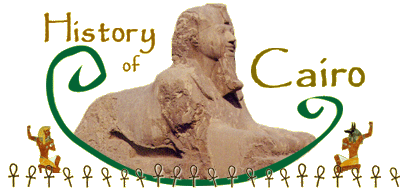 |
 |
 |
|
|||
|
History of Cairo What lower Manhattan is to the city of New York, so Memphis is to Cairo. It's the city's birthplace, though unlike lower Manhattan, it's now deserted except for busloads of tourists who come to take pictures of the gigantic, toppled statue of Pharaoh Rameses II, about all that's left of his city by the Nile.

As my well-intentioned but tedious guide bludgeoned me with details, I looked around the small, park-like setting and tried to imagine what the place must have looked like when the Greek historian Herodotus visited here in 450 B.C. Memphis was already 2,500 years old by then, founded, Herodotus writes, by Menes, first king of Egypt.

Though Herodotus is sometimes accused of stretching the truth, his report on the religious significance of Memphis was accurate. Even after subsequent pharaohs established new capitals at Thebes and Alexandria, Memphis continued to be the place where Egypt's kings were crowned. But by the third century A.D., the Nile had shifted, leaving Memphis high and dry beneath a merciless sun, while scavengers and the hot desert wind destroyed most of its temples. Islam was Egypt's new religion in the 7th century, when the Arabs established a military encampment just north of Memphis, an outpost that would eventually become the modern city of Cairo. The old capital continued to impress travelers, however, men like the Arab historian Abd al-Latif, who visited Memphis in the late 12th century. 
Arriving here by donkey seven centuries later, Victorian-era nurse and hospital reformer Florence Nightengale was just so inspired by the ancient Egyptian capital. Of all the places she visited during a tour of Egypt in 1849, none impressed her so much as the ruins of Memphis.
The pool of water is gone, but Rameses still lies here, gazing at a protective canopy now instead of the heavens, as the crowds still come to stare in wonder at him and at the dust of one of the oldest cities on earth. In Memphis, I'm Tom Verde for The Savvy Traveler Join Tom next week as he takes us to the pyramids in the company of Napoleon's troops and others on The Savvy Traveler. Thanks go to Kate MacCluggage, Hunter Steibel and David Jaffee, director of the National Theater Institute at the Eugene O'Neill Theater Center in Waterford, CT for their help in this production.
|
 | American Public Media Home | Search | How to Listen ©2004 American Public Media | Terms of Use | Privacy Policy |

